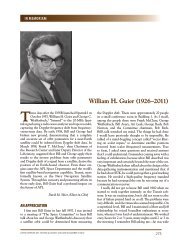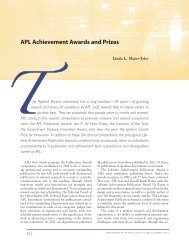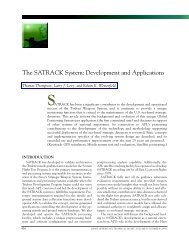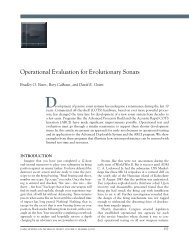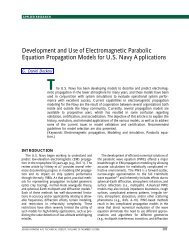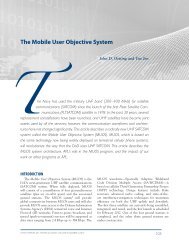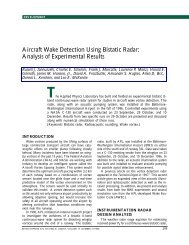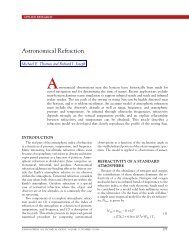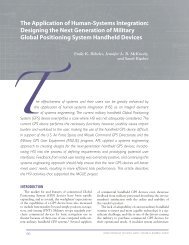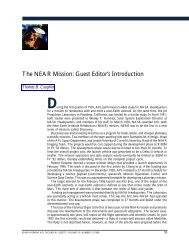A Practical Application of Relativity to Observation and Control of ...
A Practical Application of Relativity to Observation and Control of ...
A Practical Application of Relativity to Observation and Control of ...
Create successful ePaper yourself
Turn your PDF publications into a flip-book with our unique Google optimized e-Paper software.
S. B. COOPER<br />
la<strong>to</strong>r frequency <strong>and</strong> clock<br />
time are closely related, the<br />
Lorentz fac<strong>to</strong>r also describes<br />
how our observation <strong>of</strong><br />
OCXO frequency is related<br />
<strong>to</strong> the oscilla<strong>to</strong>r frequency<br />
that would be seen by an<br />
observer traveling with<br />
the spacecraft. Subtracting<br />
this effect from our data,<br />
the bot<strong>to</strong>m curve in Fig. 1,<br />
leads <strong>to</strong> the middle curve.<br />
All computations are with<br />
respect <strong>to</strong> the solar barycenter,<br />
that is, the velocity is<br />
the velocity <strong>of</strong> the spacecraft<br />
according <strong>to</strong> an observer at<br />
the solar barycenter.<br />
A particularly interesting<br />
feature <strong>of</strong> these curves<br />
is that the jump in OCXO<br />
fractional frequency <strong>of</strong>fset that appears near the end<br />
<strong>of</strong> the observed data is absent from those data after<br />
removal <strong>of</strong> the relativistic velocity effect. That jump<br />
corresponds <strong>to</strong> the simultaneous reduction in velocity,<br />
shown in Fig. 2, which resulted from the close flyby <strong>of</strong><br />
Venus. (The apparent time shift in the observed jump in<br />
OCXO frequency compared with the time <strong>of</strong> the jump<br />
in velocity is an artifact <strong>of</strong> the way the frequency jump<br />
was computed, but that detail is discussed later.)<br />
The general theory <strong>of</strong> relativity provides the <strong>to</strong>ols for<br />
underst<strong>and</strong>ing how gravity affects the output frequency<br />
<strong>of</strong> the OCXO. The stronger the gravity field experienced<br />
by the oscilla<strong>to</strong>r, the slower that oscilla<strong>to</strong>r runs, at least<br />
as seen by a distant observer in a fixed gravity field. That<br />
behavior is described by<br />
the expression −(GM/c 2 )/R,<br />
where G is the gravitational<br />
constant, M is the mass <strong>of</strong><br />
the body that is the source<br />
<strong>of</strong> the gravity, c is again the<br />
speed <strong>of</strong> light, <strong>and</strong> R is the<br />
distance from that same<br />
body. For Fig. 1, M is the<br />
mass <strong>of</strong> the Sun, <strong>and</strong> R is the<br />
distance <strong>of</strong> the spacecraft<br />
from the Sun. The gravitational<br />
effect <strong>of</strong> Venus was<br />
also examined but found <strong>to</strong><br />
be negligible on the scale<br />
shown in the figure. The<br />
residual OCXO drift rate<br />
shown, the <strong>to</strong>p curve in<br />
Fig. 1, is the result <strong>of</strong> subtracting<br />
both the gravitational<br />
effect <strong>and</strong> the velocity<br />
390<br />
Frequency <strong>of</strong>fset (clock drift rate) (ppb)<br />
35<br />
30<br />
25<br />
20<br />
15<br />
10<br />
5<br />
Actual MET drift rate<br />
MET drift rate minus velocity effect<br />
Spacecraft velocity<br />
0<br />
0<br />
960 970 980 990 1000 1010 1020 1030 1040 1050<br />
Days since launch<br />
Figure 2. MESSENGER OCXO-B behavior after March 2007 turn-on, with relativistic velocity effect<br />
removed.<br />
Fractional frequency <strong>of</strong>fset (clock drift rate) (ppb)<br />
15<br />
10<br />
5<br />
0<br />
–5<br />
–10<br />
–15<br />
–20<br />
effect from the observed data. The variation <strong>of</strong> residual<br />
frequency <strong>of</strong>fset from 31.0 ppb <strong>to</strong> 30.4 ppb over 70 days<br />
is reasonable <strong>and</strong> can be explained by a combination <strong>of</strong><br />
temperature effects <strong>and</strong> oscilla<strong>to</strong>r frequency aging.<br />
This tells us that, after removal <strong>of</strong> the relativistic<br />
effects, the OCXO was running fast by approximately<br />
30–31 ppb, approximately 2.6–2.7 ms/day.<br />
TDTRATE AND THE MERCURY FLYBYS<br />
After the 2007 flyby <strong>of</strong> Venus, the MESSENGER<br />
spacecraft flew past Mercury three times <strong>and</strong> then, in<br />
a fourth encounter, went in<strong>to</strong> orbit around Mercury.<br />
From the Venus flyby, we were able <strong>to</strong> infer from the<br />
Estimated OCXO-B frequency<br />
<strong>of</strong>fset with relativistic effects<br />
Estimated TDTRATE with<br />
relativistic effects<br />
–25<br />
0.99999998500<br />
1220 1240 1260 1280 1300 1320 1340 1360<br />
Days since launch<br />
JOHNS HOPKINS APL TECHNICAL DIGEST, VOLUME 32, NUMBER 1 (2013)<br />
50<br />
45<br />
40<br />
35<br />
30<br />
25<br />
20<br />
15<br />
10<br />
5<br />
1.00000002500<br />
1.00000002000<br />
1.00000001500<br />
1.00000001000<br />
1.00000000500<br />
1.00000000000<br />
0.99999999500<br />
0.99999999000<br />
Figure 3. Estimated MESSENGER OCXO-B fractional frequency <strong>of</strong>fset <strong>and</strong> TDTRATE during M1 due<br />
<strong>to</strong> relativity, assuming +31 ppb <strong>of</strong>fset without relativity.<br />
Spacecraft velocity (km/s)<br />
TDTRATE (s/s)





